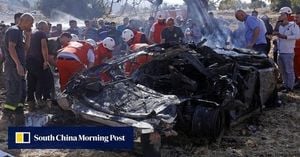South Korea’s export sector is showing robust signs of recovery in 2025, with both traditional manufacturing and high-tech defense industries posting strong gains despite global economic headwinds and geopolitical uncertainty. Recent data from Statistics Korea and industry filings, as reported by Yonhap News and other outlets, reveal a nuanced but optimistic picture: while large corporations continue to anchor the nation’s trade, small and mid-sized enterprises are making outsized contributions, and defense manufacturers are reaping record profits on the back of surging arms exports.
According to provisional figures released by Statistics Korea on August 14, South Korea’s exports in the second quarter of 2025 reached $175.2 billion. This represents a 2.1% increase from the same period last year, marking a welcome rebound from the 2.3% decline recorded in the first quarter. The improvement is all the more notable given the backdrop of persistent concerns over U.S. tariffs and a volatile global trade environment.
Large corporations, which typically dominate the country’s export landscape, saw their overseas shipments rise by 0.5%. This modest gain was primarily propelled by capital goods—especially high-performance semiconductors and IT components. While exports of minerals, chemical products, and durable consumer goods saw declines, the strength in transportation equipment and IT hardware more than compensated for these weaknesses.
Mid-sized enterprises outperformed their larger counterparts, posting a 3.7% year-on-year increase in exports. Their growth was supported by both capital goods and consumer products, with IT components, machinery, and direct-to-consumer goods standing out as particularly strong performers. Small enterprises led the pack, achieving a 6.3% rise in exports thanks to broad-based gains across durable and non-durable consumer goods, minerals, and transportation equipment.
One of the biggest stories behind these numbers is the semiconductor sector. The global surge in demand for high-performance chips—fueled by the rapid expansion of artificial intelligence and data centers—has helped South Korea’s manufacturers achieve record-high export performance. Manufacturing exports as a whole grew 3.4%, led by electrical and electronic products as well as transportation equipment. In contrast, the wholesale and retail trade sector saw a 9.3% decline, suggesting that not all segments of the economy are benefiting equally from the export recovery.
When analyzed by company size, those with between 1 and 9 employees saw their exports jump an impressive 13.4%. However, firms with 10 to 249 employees experienced a 9.8% decline, while those with 250 or more employees recorded a 3.7% increase. This divergence hints at the complex dynamics facing smaller businesses, which may be more agile but also more vulnerable to market fluctuations.
Capital goods exports were a bright spot, rising 8.3% on the strength of IT component and transportation equipment sales. However, exports of raw materials fell 6.0%, and consumer goods dipped 3.8%. The total number of exporting companies in the second quarter reached 68,582, up 2.5% from the previous year—a sign that more firms are seeking opportunities abroad.
The concentration of export power remains high: the top 10 exporters accounted for 37.8% of total exports (a slight increase from last year), while the top 100 made up 65.9% (a marginal decrease). Imports, meanwhile, totaled $154.3 billion, down 1.7%. Large corporations’ imports fell 5.4%, but mid-sized and small enterprises increased imports by 4.3% and 3.6%, respectively. Manufacturing imports decreased 3.8%, while other industries and wholesale and retail trade posted modest gains.
Against this backdrop of broad-based export recovery, South Korea’s defense industry stands out for its extraordinary growth—underscoring the country’s emergence as a global arms supplier. According to industry data published on August 17, the nation’s five leading defense firms—Hanwha Aerospace Co., LIG Nex1 Co., Korea Aerospace Industries (KAI), Hyundai Rotem Co., and Hanwha Systems Co.—reported a combined operating profit of 2.3 trillion won for the first half of 2025. That’s a staggering 161.2% increase from 880.7 billion won a year ago, and it already represents nearly 80% of their full-year operating profit for 2024.
Combined sales for these defense giants nearly doubled to 19.2 trillion won from 9.9 trillion won in the same period last year. Hanwha Aerospace led the way, posting a record 1.43 trillion-won operating profit for the first half—quadruple its earnings from the previous year—while its sales more than tripled to 11.8 trillion won. LIG Nex1’s operating profit soared by 64.6% to 191.2 billion won, with sales up 35.4% to 1.9 trillion won. KAI, though posting a smaller 7.9% increase in operating profit (to 132 billion won), saw its sales fall 6.4% to 1.5 trillion won. Hyundai Rotem’s operating profit surged 192.4% to 460.4 billion won, with sales up 40% at 2.6 trillion won. Hanwha Systems, meanwhile, reported a 29.5% drop in operating profit to 91.6 billion won, but sales rose 18.4% to 1.5 trillion won.
What’s driving this boom? Industry officials point to robust overseas demand, particularly amid heightened geopolitical risks in the Middle East and Europe. Hanwha Aerospace’s second-quarter overseas sales jumped 43% year-on-year, thanks in large part to exports of defense systems like the Chunmoo multiple rocket launcher. Hanwha Systems saw its second-quarter sales rise 11.8%, buoyed by deliveries of multi-function radars for the Cheongung-II medium-range surface-to-air missile system to the United Arab Emirates and Saudi Arabia. KAI racked up 227.3 billion won in second-quarter overseas sales, largely due to exports of its FA-50 fighter jets to Poland and Malaysia.
With a combined order backlog of 111.9 trillion won, market watchers expect the defense sector’s growth momentum to continue through the second half of 2025 and beyond. As one industry official, speaking anonymously, told Yonhap News, "With continuous overseas orders for flagship products and deliveries, we have a positive outlook for the second half of the year and beyond."
While the headlines are dominated by the defense sector’s spectacular results, the broader export recovery is a testament to South Korea’s ability to adapt and innovate across multiple industries. The country’s exporters—large and small—are navigating global uncertainty with a mix of resilience, technological prowess, and strategic diversification. As the world continues to grapple with economic and geopolitical challenges, South Korea’s export engine is proving to be a source of both stability and dynamism.
With the second half of 2025 underway, all eyes will be on whether these positive trends can be sustained, and whether the nation’s exporters—old and new—can continue to find success on the global stage.



